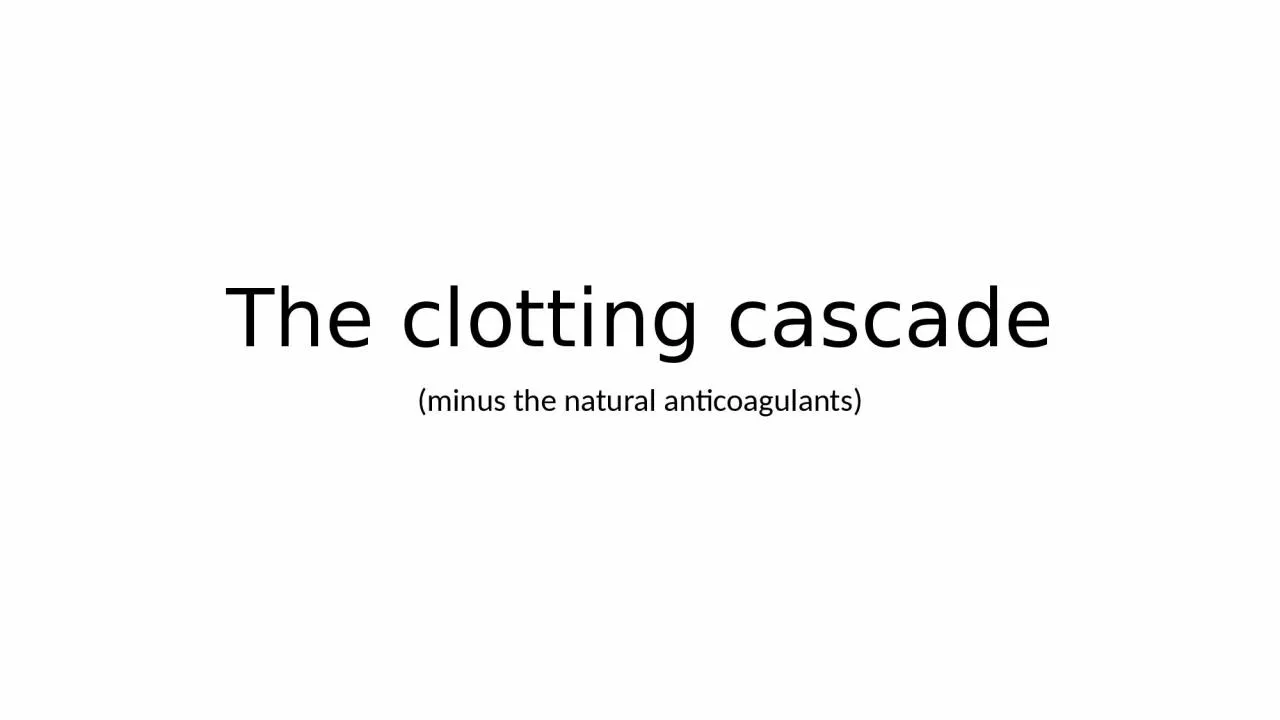

Fibrin Fibrinogen Start with the bottom line fibrin formation After all this is what the clotting cascade is designed for Fibrin Fibrinogen 2 ways to get to bottom line Intrinsic pathway Extrinsic pathway ID: 917982
Download Presentation The PPT/PDF document "The clotting cascade (minus the natural ..." is the property of its rightful owner. Permission is granted to download and print the materials on this web site for personal, non-commercial use only, and to display it on your personal computer provided you do not modify the materials and that you retain all copyright notices contained in the materials. By downloading content from our website, you accept the terms of this agreement.
Slide1
The clotting cascade
(minus the natural anticoagulants)
Slide2Fibrin
Fibrinogen
Start with the bottom line: fibrin formation. After all, this is what the clotting cascade is designed for
Slide3Fibrin
Fibrinogen
2 ways to get to bottom line:
Intrinsic pathway
Extrinsic pathway
Intrinsic pathway
Extrinsic pathway
Slide4Fibrin
Fibrinogen
Intrinsic pathway
Extrinsic pathway
aFVII
Extrinsic pathway is initiated when blood is exposed to subendothelial surface, where factor VII (FVII) comes into contact with tissue factor, leading to activated FVII (aFVII)
FVII is the only factor in the extrinsic pathway
Slide5Fibrin
Fibrinogen
Intrinsic pathway
Extrinsic pathway
aFVII
aFXII
Intrinsic pathway is initiated when blood is exposed to negatively charged
surface such as glass or clay, leading to activation of FXII
Slide6Fibrin
Fibrinogen
Intrinsic pathway
Extrinsic pathway
aFVII
aFXII
FXII activates FXI, which in turn activates FIX (only the inactive factors are shown for simplicity). FIX activates FX of the common pathway using FVIII as a cofactor
FVIII
FXI
FIX
FX
Slide7Fibrin
Fibrinogen
Intrinsic pathway
Extrinsic pathway
aFVII
aFXII
FVIII
FXI
FIX
FX
In vivo h
emostasis is always initiated by the extrinsic pathway. Once activated FVII activates FX of the common pathway and FIX of the intrinsic pathway
Slide8Fibrin
Fibrinogen
Intrinsic pathway
Extrinsic
pathway
aFVII
aFXII
FVIII
FXI
FIX
FX
Extrinsic and intrinsic
pathways converge on FX of the common pathway. Once activated, FX (and its cofactor FV) activate prothrombin, leading to thrombin generation. Thrombin, in turn, cleaves fibrinogen, leading to formation of insoluble fibrin
Prothrombin
thrombin
Common pathway
FV
Slide9Fibrin
Fibrinogen
Intrinsic pathway
Extrinsic pathway
aFVII
aFXII
FVIII
FXI
FIX
FX
aPTT measures integrity of the intrinsic pathway by activating FXII
Prothrombin
thrombin
Common pathway
FV
aPTT
PT
PT measures integrity of the extrinsic pathway by activating FVII
Slide10Fibrin
Fibrinogen
aFVII
FVIII
FXI
FIX
FX
Prothrombin
thrombin
FV
We need to consider FXII when performing an aPTT because deficiency FXII can lead to a prolonged test result. However, FXII does not play a role in in vivo hemostasis. So, let
’s remove it from the scheme.
In vivo hemostasis
Hemostasis starts with tissue factor-mediated activation of FVII
aFVII activates FIX in intrinsic pathway
Both aFVII and aFIX activate FX in the common pathway, leading to thrombin generation and fibrin formation
Thrombin feeds back to activate several factors, including FXI of the intrinsic pathway. The importance of FXI in hemostasis varies between individuals
1
2
3
4
Slide11Fibrin
Fibrinogen
aFVII
FVIII
FXI
FIX
FX
Prothrombin
thrombin
FV
In vivo hemostasis
1
2
3
X-linked Fibrin
FXIII
One more step to remember: fibrin is crosslinked by factor XIII (FXIII), makin
g it strong and insoluble. PT and aPTT assays are unable to tell the difference between uncrosslinked and crosslinked fibrin. Other assays are required to demonstrate FXIII deficiency